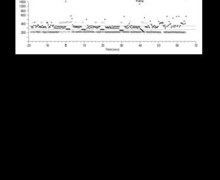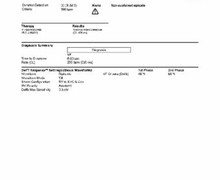Undersensing of VF episode after a change in the programmed sensitivity
Tracing
Manufacturer Microport CRM
Device CRT
Field Standard parameters
N° 7
Patient
This 67-year-old man received a Microport CRM-Sorin Paradym RF SonR triple chamber defibrillator in the context of ischemic cardiomyopathy with long PR and left bundle branch block. Episodes of ventricular oversensing with modification of the programmed ventricular sensitivity (0.8 mV). Hospitalization in emergency after an episode of syncope with delivery of DC shock.

Graph and trace
- atrial sensing and BiV stimulation.
- episode of polymorphous VT accurately detected initially with a few underdetected cycles.
- increase in ventricular undersensing with first paced cycle.
- major ventricular undersensing with succession of BiV stimulated cycles.
- improved ventricular sensing.
- delivery of 39 J shock.
- successful shock and return of sinus rhythm followed by BiV stimulation.
Other articles that may be of interest to you







Ventricular sensitivity is a key parameter in the programming of triple chamber defibrillators, requiring a balance between the elimination of all oversensing, including P-waves, T-waves and myopotentials, which might decrease the percentage of stimulation, and the ability to accurately detect, hence treat, an episode of polymorphic ventricular tachyarrhythmia. On earlier tracings, episodes of ventricular oversensing were present that might have required changes in the ventricular sensitivity in order to restore consistent BiV stimulation. These compromises of programming may have harmful consequences for recipients of defibrillators. This patient presented with several episodes of ventricular oversensing, probably caused by diaphragmatic myopotentials, and the programmed ventricular sensitivity was lowered (0.8 mV; nominal value = 0.4 mV). This tracing illustrates the limits of this type of strategy, with an actual episode of underdetected VF delaying the diagnosis. The verification of an accurate detection of induced VF may follow any reprogramming of the ventricular sensitivity, despite the known limitations of this type of procedure.